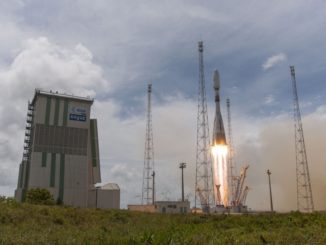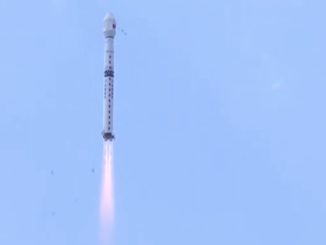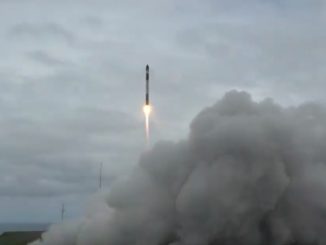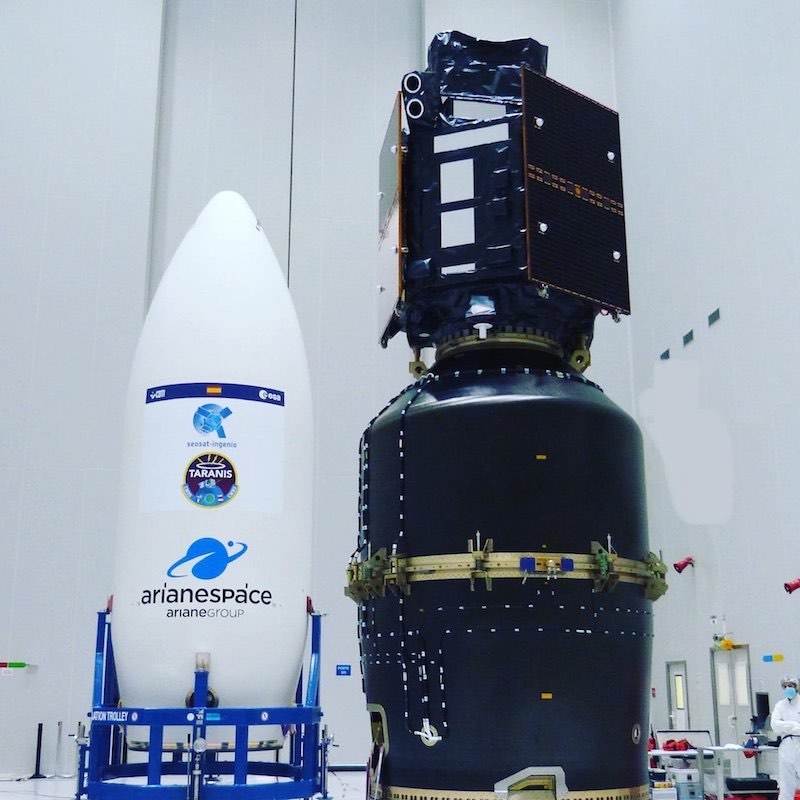
A Spanish Earth observation spacecraft and a French research satellite to probe luminous phenomena above thunderstorms are packaged inside the nose cone of an Italian-built Vega rocket for launch Monday night from French Guiana.
The two satellites will share the ride into orbit after the Vega rocket blasts off from the Guiana Space Center on the northeast coast of South America at 8:52:20 p.m. EST Monday (0152:20 GMT Tuesday).
Spain’s SEOSAT-Ingenio satellite will ride in the upper position of the Vega rocket’s Vespa dual-payload dispenser, while France’s Taranis research payload will launch in the lower berth of the Vega payload shroud.
The 98-foot-tall (30-meter) Vega launcher, developed by the Italian aerospace company Avio, will take off on its 17th flight Monday night.
Three solid-fueled stages will propel the rocket north from French Guiana over the Atlantic Ocean, then hydrazine-fueled upper stage will ignite four times to inject the SEOSAT-Ingenio and Taranis satellites into two slightly different polar orbits.
If all goes according to plan, the Vega rocket’s upper stage will deploy SEOSAT-Ingenio at 9:46 p.m. EST (0246 GMT) into a 416-mile-high (760-kilometer) orbit with an inclination of 98.09 degrees to the equator. After a second pair of orbital adjustment burns, the upper stage will release Taranis at 10:34 p.m. EST (0334 GMT) into a slightly higher 420-mile-high orbit with an inclination of 98.19 degrees.
A final burn by the upper stage will deorbit the rocket body back into Earth’s atmosphere to prevent it from becoming another piece of space junk.
SEOSAT-Ingenio, built by Airbus in Spain, weighs around 1,650 pounds (750 kilograms), according to a press kit released by Arianespace, the launch service provider for the mission. Carrying two optical cameras, the satellite will have an imaging resolution of around 8.2 feet, or 2.5 meters, in black-and-white. Its cameras will take pictures along swaths 34 miles (55 kilometers) wide.
The spacecraft’s observing instrument will also collect data in blue, green, red and near-infrared wavelengths, and the satellite is designed to be able to look sideways to image regions on each side of its ground track. Data from the mission will help scientists, policymakers, and other users track changes in land use.
SEOSAT-Ingenio “will provide our society with a very large range of optical images for many applications such as land use, border control, climate change, and security,” said Jorge Lomba Ferreras, head of the aerospace programs department at CDTI, the Spanish Center for the Development of Industrial Technology, part of the Ministry of Economy and Competitiveness.
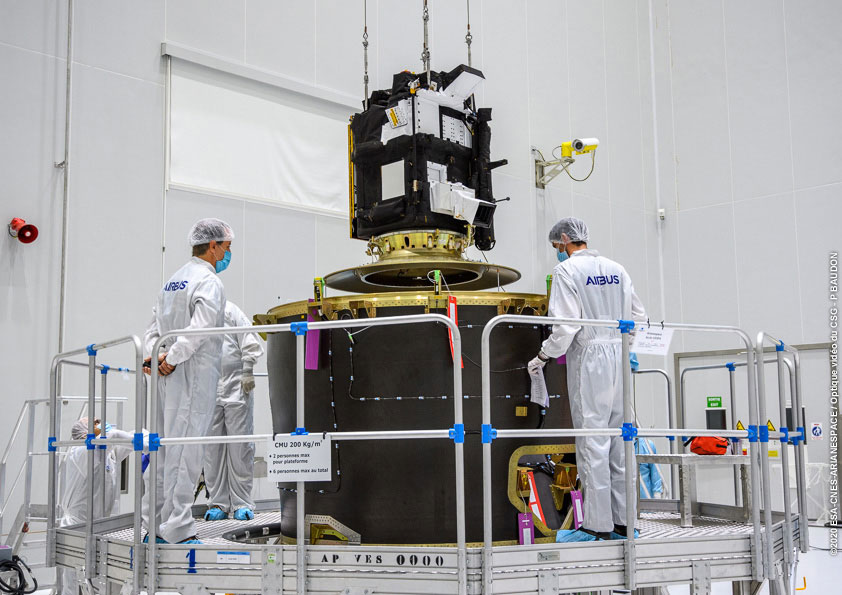
Designed primarily for civilian use, SEOSAT-Ingenio will also collect imagery for the European Commission’s Copernicus program, which includes a fleet of dedicated Sentinel environmental monitoring satellites. As a contributing mission in the Copernicus fleet, SEOSAT-Ingenio will supplement data gathered by the Sentinel satellites distributed worldwide and free of charge.
“SEOSAT is a very versatile satellite and serves many domains of applications, from agriculture to disaster management, also fisheries, forest fires, there are many (areas) where SEOSAT can be used,” said Josef Aschbacher, director of Earth observation programs at the European Space Agency.
ESA managed development of the SEOSAT-Ingenio on behalf of the Spanish government, which funded the mission and owns the satellite. ESA also organized the data pipeline to distribute SEOSAT-Ingenio imagery to global users, and ESA operators in Germany will oversee the satellite’s early activation and commissioning after launch, before handing over control to Spanish engineers.
Designed for a mission of at least seven years, the spacecraft will primarily take images over Spain, other parts of Europe, North Africa, and Latin America. But SEOSAT-Ingenio’s orbit enables worldwide coverage, and its geographic reach will span the globe.
“SEOSAT-Ingenio will help us to better understand climate change,” Aschbacher said. “For example, one important parameter in climate change is land use change, change from agricultural areas into urban areas, or from forested areas into non-forested areas. SEOSAT, through its routine operation and routine monitoring of the land surface, certainly helps a lot to better understand a very important parameter of climate change.”
Another goal of the SEOSAT-Ingenio project, which Spain’s government kicked off in 2007, was to foster a growing Spanish space industry. About 80 percent of the spacecraft was manufactured in Spain, while previous Spanish government satellites were only about half-manufactured in Spain, according to Lomba Ferreras.
The first test images from SEOSAT-Ingenio should be downlinked within two or three weeks after launch, Lomba Ferreras said in a virtual pre-launch press conference Monday. The satellite should be fully operational by April 2021, he said.
Juan Carlos Cortés, director of space and dual programs at CDTI, said the SEOSAT-Ingenio project has cost around 200 million euros, or $236 million.
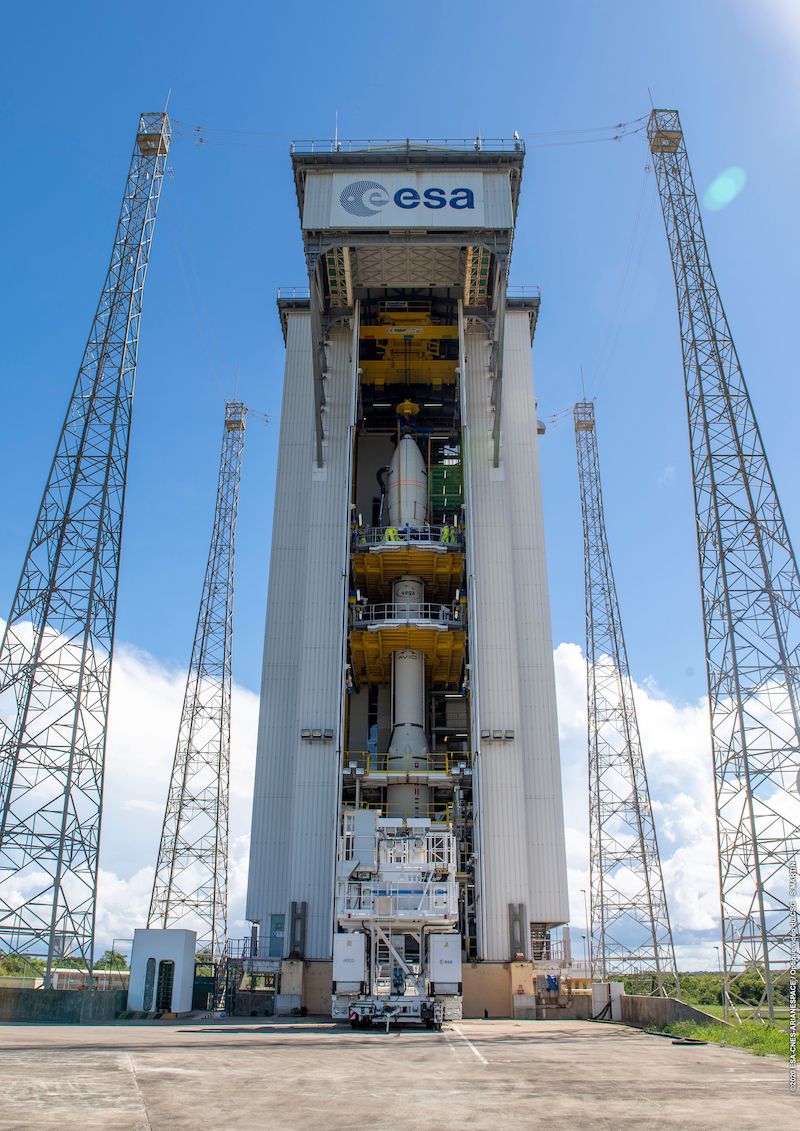
The French Taranis research satellite is launching on a mission to trace the origins of mysterious luminous phenomena above thunderstorms. These Transient Luminous Events, or TLEs, are electrical discharges that last just milliseconds, and scientists are unsure of the mechanisms and physics the produce them.
TLEs manifesting themselves as red sprites and blue jets are sometimes visible on dark nights, especially from aircraft. Phenomena known as elves are the most difficult to detect, requiring special photographic equipment.
Long theorized with sporadic observations which were spread by word-of-mouth, bright electrical bursts above thunderstorms were first documented in 1989 by ground-based observations and instruments on the space shuttle. Scientists know little about how the discharges are triggered, or how they reach so high in the atmosphere, near the edge of space.
Taranis, led by the French space agency CNES, will attempt to untangle what triggers these brief flashes above thunderstorms, and how TLEs might affect conditions within the atmosphere or in space.
The 385-pound (175-kilogram) Taranis satellite “will be capable of detecting these phenomena and recording their light and radiation signatures at fine resolution, as well as the electromagnetic disturbances they generate in the upper layers of Earth’s atmosphere,” CNES said in a press release.
The instruments aboard Taranis include cameras, X-ray and gamma-ray detectors, electron detectors, a magnetometer, and sensors to detect plasma and electric fields in space.
Taranis will also study Terrestrial Gamma-ray Flashes, or TGFs, brief bursts of gamma-ray photons observed emanating from thunderstorms around the world.
“Taranis is the first space mission combining optical, gamma, energetic particles and eletric and magnetic measurements to improve our understanding of these phenomena,” said Jean-Louis Pinçon, science lead for the Taranis mission from CNRS, the French national scientific research center. “Ultimately, once the generation mechanisms will be fully understood, we will have the possibility to estimate the real impacts of TLEs and TGFs on the physics and chemistry of the upper atmosphere.”
After the launch, Taranis will deploy instrument booms and begin several months of commissioning and validation. Scientific data should be available from Taranis next June, Pinçon said in response to written questions from Spaceflight Now.
CNES has spent about 115 million euros, or $136 million, on the Taranis project since it began in 2010. The mission is designed to operate for two to four years, Pinçon said.
Email the author.
Follow Stephen Clark on Twitter: @StephenClark1.

